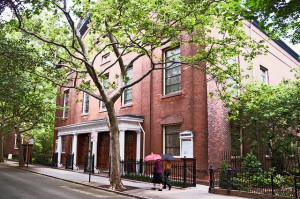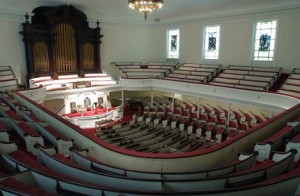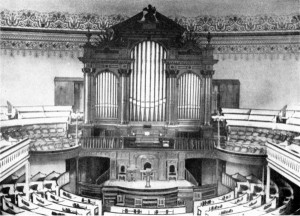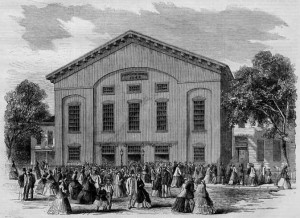The location that I have chosen is the Plymouth Church in Brooklyn Heights on Hicks Street. I chose this location mainly because of my own background of going to church. I’m interested in discovering some of the Christian influence involved in the history of Brooklyn Heights. I am almost completely unfamiliar with Brooklyn in general, so I wanted to take the chance and use the Plymouth Church to start “building my own private New York”, or my own private Brooklyn in my case.
I first discovered the Plymouth Church during the walk around Brooklyn Heights our class took on the 30th of September. I took a walk to this location again by myself on October 8th after attending my classes on Tuesdays. I started walking to the Plymouth Church by walking along Jay Street. I walked along Jay Street for a short while and then I crossed the street and started walking along Tillary Street. I kept on walking until I reached the Korean War Veterans Plaza. I crossed the street again and started walking along Cadman Plaza W until I crossed the street yet again and started walking on Clark Street. I kept on walking until I reached Hicks Street and then I continued along until I finally reached the church.
The Plymouth Church is one of the oldest churches in Brooklyn. It was founded in Brooklyn Heights in 1847 by 21 men and women who were New Englanders and wanted a Congregational church. The first pastor who was appointed to pastor the church was none other than Henry Ward Beecher. Two years after the founding of the church, a fire burned and damaged the original church on Cranberry Street. The church building that exists today was built on Orange Street behind where the original church building used to be. The first church building was rebuilt into a building that contained offices, parlors and Sunday School rooms that belonged to the church.
There is a lot of important history surrounding the Plymouth Church. Most of it involves Henry Ward Beecher and the church’s role in anti-slavery. Beecher was a powerful speaker and he put a lot of emphasis on anti-slavery. While being under Beecher’s influence, the Plymouth Church held ties with the Underground Railroad. The Underground Railroad was a secret network of people who helped slaves escape to the North from their slave owners. Beecher created several public events that he used to promote opposition of slavery. For example, he would stage mock “auctions” at the church so that the congregation members of the church could purchase the freedom of some of the slaves. During one of Beecher’s services, he broke the chains binding John Brown. Beecher also took the liberty of inviting several people who promoted anti-slavery to speak at the church including William Lloyd Garrison, Sojourner Truth, Wendell Phillips, Charles Sumner, and Frederick Douglass. As pastor of the church, Beecher also supported congregational singing during church services. Along with his brother, Charles Beecher, and the church’s organist, John Zundel, Henry Beecher compiled a book of hymns called The Plymouth Collection. It was published in 1855 and it was the world’s first modern hymnal that had words and music printed on the same page. In February of 1860, Abraham Lincoln was invited to speak at the church. Unfortunately, the speech Lincoln was going to give at the church had to be moved to The Great Hall of The Cooper Union in Manhattan. Lincoln did, however, attend a church service at the Plymouth Church. It is the only church in New York City that Lincoln ever attended. Many famous writers and activists have also had opportunities to speak at the Plymouth Church like Mark Twain, Clara Barton, Charles Dickens, Ralph Waldo Emerson, Horace Greeley, and William Thackery.
In 1934, Plymouth Church combined with a neighboring church called the Church of the Pilgrims. The Church of the Pilgrims church was the first Congregational church in Brooklyn. The two churchs merged and became the Plymouth Church of the Pilgrims. However, in September of 2011, the name of the church was changed back to the Plymouth Church. The Plymouth Church became designated National Historic Landmark in 1961 by the National Register of Historic Places because of the church’s significant role in American History.
After researching and looking at the building itself, I couldn’t help but notice all of its involvement in anti-slavery. However, despite of all of it, as Whitehead said in “City Limits”, it is not apart of my Plymouth Church. White said, “Never listen to what people tell you about old New York, because if you didn’t witness it, it is not apart of your New York and might as well be Jersey.” I use this quote from Whitehead in this situation. My Plymouth Church isn’t a church that puts emphasis on promoting anti-slavery as historical documents may say, but it is a modern church that puts emphasis on reaching out to its community and expanding throughout Brooklyn Heights. One juxtaposition I noticed with this church was the appearance. The design of the outside of the church changed little by little, but the design of the inside remained generally the same all these years with the exception of electricity. As the next step, I want to learn more about how this church conducts services. One day, I want to observe one of their church services and see how it resembles the past Plymouth Church. Do they conduct services differently from the past? Or do they keep tradition and conduct services in the same orderly manner as they have in the past?
I think it is safe to say that Plymouth Church is apart of “my” Brooklyn. Like what Whitehead said, it became “apart of my private New York” the first time I laid eyes on it.
Works Cited
Whitehead, Colson. “City Limits.” The Colossus of New York: A City in Thirteen Parts. New York: Random House, 2004. 1-12.
“Plymouth Church :: About Our Church.” Plymouth Church :: About Our Church. N.p., n.d. Web. 16 Oct. 2013.







